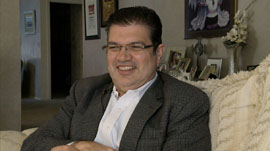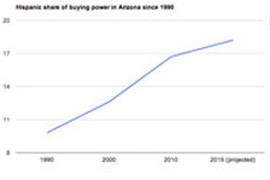Cronkite News has moved to a new home at cronkitenews.azpbs.org. Use this site to search archives from 2011 to May 2015. You can search the new site for current stories.
New report shows surge in Hispanic market’s buying power
PHOENIX – As the state’s fastest-growing demographic group, Hispanics also are the fastest-growing market for Arizona businesses.
A new report sheds light on how fast that growth may be in coming years.
DATOS: Tucson, released last week by the Arizona Hispanic Chamber of Commerce and Tucson Hispanic Chamber of Commerce, forecasts that Hispanics will account for $40 billion of Arizona’s consumer spending during 2012. That figure will rise to $50 billion by 2015, the report said.
While focused primarily on Pima County, the report points to statewide figures and trends on the Hispanic market’s growth.
“It’s not a prophecy; it’s about mathematics,” said Loui Olivas, a professor emeritus at Arizona State University’s W.P. Carey School of Business who led the research.
Hispanics account for about 30 percent of Arizona’s population at present and have a fertility rate almost twice that of white non-Hispanics.
“When a corporation or company is looking to see who is spending more, it’s the Hispanic market,” said Olivas, who also is vice president of education partnerships at ASU.
That market is younger and has more people per household. The median age of Hispanics in Arizona is 25.8 as opposed to 45.1 for non-white Hispanics, Olivas said.
And Hispanics as a group have larger families, the report found. Sixty-nine percent of Latinas, for example, live in households with four or more people, compared to 32 percent among non-Hispanics.
The report said Latino purchasing power in Pima County will reach $8 billion by 2015. Meanwhile, it said, Hispanics will account for almost two-thirds of Tucson’s new homeowners between now and 2017.
“If you’re a realtor in southern Arizona and you haven’t been considering how to reach the Hispanic market, you might want to think about doing so,” said Lea Márquez-Peterson, president and CEO of the Tucson Hispanic Chamber of Commerce.
Márquez-Peterson said she hopes the findings will encourage businesses, nonprofits and political parties to recognize the importance of Hispanic consumers and businesses, which she said are often overlooked.
“Population growth trends are something that we want them to remember and consider as they make decisions,” she said. “There’s so much more to having a bi-cultural experience in business.”
Hispanics accounted for 16.7 percent of Arizona’s buying power in 2010, up from 9.8 percent in 1990, according to the Selig Center for Economic Growth at the University of Georgia’s Terry College of Business. Buying power refers to disposable income available for spending after taxes.
James Garcia, director of strategic communication and policy at the Arizona Hispanic Chamber of Commerce, said advertising aimed at the Hispanic community is still disproportionately small compared to that market’s size.
As businesses look to tap into this market, they’ll have to consider Hispanic culture, he said.
“Do they have people that are bilingual? Are they aware of the fact that on average a Hispanic family tends to be larger?” Garcia said. “Do they know what the average income level is?”
Raul Hinojosa-Ojeda, associate professor in the UCLA Cesar E. Chavez Department of Chicana and Chicano Studies, said Hispanics in the U.S. illegally also are important to Arizona’s economic health.
He conducted a study, released in August by the Center for American Progress, suggesting that legalizing Arizona’s illegal immigrants would result in an extra $540 million in state tax revenue.
“People working are highly repressed in their ability to work,” Hinojosa-Ojeda said. “[Legalization] directly results in greater consumption, economic activity, tax revenue.”









